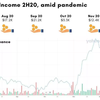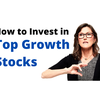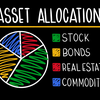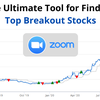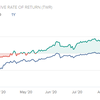My portfolio surged 62% in 2020. Here's how I’m positioned entering 2021.
As we enter 2021, I’ve been reflecting on my portfolio's performance over the last year, thinking about the decisions that went well and the areas that I could improve on to become a better investor going forward.
In this article, I’m going to share my top 3 lessons I learnt from the market in 2020 and how my portfolio is positioned entering 2021.
Performance Review
In 2020, my portfolio was up 61.8% vs the S&P 500 which was up 16.7%, outperforming the benchmark by 45.1%. The portfolio’s maximum drawdown this year was 15.2% while the S&P 500 lost over 30% during the March correction. Achieving almost 4X the returns of the benchmark with half the amount of risk, I’m pretty satisfied with my portfolio’s performance this year.
Diving deeper, the plot below shows the daily distribution of returns of my portfolio (blue bar) against the various benchmarks. The horizontal axis shows the daily performance of the portfolio and the vertical axis shows the number of instances. Two key areas of this plot stand out.
Firstly, on the left side of the plot, we can see that all the benchmarks suffered a few days of losses between -10% and -12%. This corresponded to the sell off we saw in March this year due to Covid-19. Fortunately, my portfolio did not experience a single day of loss between -10% and -12% this year due to my model’s active risk management system where my portfolio was mostly holding cash in March. This protected my portfolio from large drawdowns during such corrections.
Secondly, my portfolio has around 32 days with returns between 2% and 4% as compared to the benchmarks which have less than 16 days with returns between 2% and 4%. This outperformance is attributed to stock selection where my model picked stocks that had much higher returns than the benchmarks. My model uses a combination of trend following with fundamental analysis to select stocks that have strong odds of outperforming the market. For more details on my investment strategy you may refer to this article.
These 2 factors were the main reasons why my portfolio outperformed the benchmark by 45.1% this year. Risk management and stock selection.
Based on this performance, here are my top 3 lessons.
Be greedier when others are greedy
You know how Warren Buffet likes to preach that you should be “fearful when others are greedy, and greedy when others are fearful”? I do the opposite.
Instead of being fearful when others were greedy, I was greedier than others when the stock market started recovering after the sell off in March. Between April and May, my model aggressively started buying stocks and reduced my cash allocation from 90% down to 0% to participate in the rebound.
I also started increasing my portfolio’s leverage with margin on my Interactive Brokers account to amplify my gains from this opportunity.
Thankfully, this decision paid off massively as the market went on to make a V shaped recovery causing my portfolio to surge to new highs.
Amount of cash in my portfolio
Diversify, diversify, diversify
The next lesson I learnt was to hold at least 30 stocks, equally weighted in my portfolio. No exception. After spending 2020 invested in the stock market, I am even more convinced that diversification is absolutely essential to any portfolio.
My biggest winners in 2020 were CrowdStrike (CRWD), Tesla (TSLA), Amazon (AMZN), Netflix (NFLX), and Sea (SE) while my biggest losers were Alibaba (BABA), Zoom (ZM), Becton Dickinson (BDX), Walmart (WMT), and Grocery Outlet (GO).
If I had a crystal ball, I would have picked only the winners and left out all the losers listed above. However the truth is that no one has a crystal ball to see into the future. All the stocks listed above were in an uptrend and had solid fundamentals. If I did not diversify my portfolio and picked 5 stocks instead of 30 stocks, I could have ended up holding my 5 biggest losers which would have been an absolute disaster. Concentration risk is not rewarded by the market.
The key here is that by having a diversified portfolio of 30 stocks, I’m betting that my model is able to select more winners than losers and that the gains from the winners are higher than the losses from the losers. I just need a couple of winning stocks like CrowdStrike, Tesla, and Sea, to pay for all the losers and drag my portfolio to new highs.
It’s ok to sin a little
There were quite a number of tech IPOs this year. Unfortunately because these stocks were new and only recently listed on the stock exchange, my website did not have enough historical data to include the stocks as part of the model’s portfolio.
However, I could not resist dabbling in some of these stocks and bought Palantir (PLTR) even though it was not recommended by my live strategy on pyinvesting.com.
This is because of Palantir’s amazing business model and growth potential as an AI company that helps other companies improve their business efficiency by learning from their data.
Even though I broke my rules and did not follow the model completely, I kept the weight of Palantir to 3.3% of my portfolio. This weight was similar to every other stock in my portfolio. By capping the weight of Palantir to 3.3%, the risk to my portfolio is minimal. Moreover it keeps me excited, owning a shiny new AI stock in my portfolio.
How am I positioned going forward?
The market is starting to get overstretched in the short term where the S&P 500 is trading 14% above its 200 day moving average. While the market can most certainly continue going up, I don’t see the same upside going forward as compared to March 2020 when the S&P 500 sank by over 30% in a couple of weeks. The boat has sailed and the risk reward ratio is no longer as attractive.
After having a record year with 62% returns, I think the smart thing to do now is to cash in on some of my profits and reduce my leverage. To be clear, I’m not selling my entire portfolio and putting cash in the bank. I’m simply reducing my leverage to lock in some profits while continuing to stay fully invested in the market.
I’m also starting to add some stocks that could disrupt their industries to stay on the right side of change. According to Catherine Wood, CEO of ARK Invest, we live in an age where “record-breaking technological changes are creating not only exponential growth opportunities but also black holes in global economies and financial markets”. These new disruptive stocks have huge growth potential and are likely to drive my portfolio’s returns going forward.
As these stocks have been added into my investment universe, they are now eligible to be selected by my model if they start trending and are accompanied with strong fundamentals.
If you enjoyed this article and would like to create your own investment strategy on the cloud, I invite you to check out PyInvesting’s new beginners backtest where we will guide you through an example and help you understand how the website works. I hope that PyInvesting helps you in your journey towards financial freedom.
Happy investing, and may the odds be in your favor.


